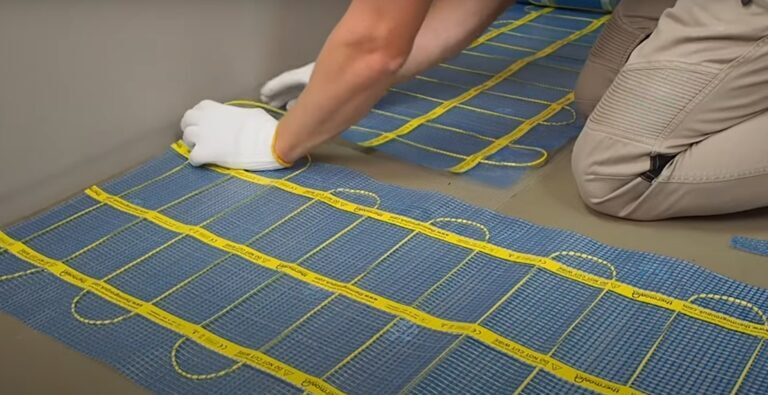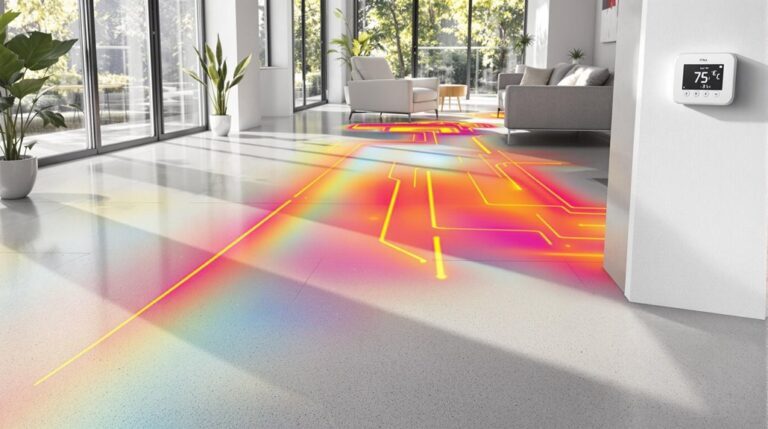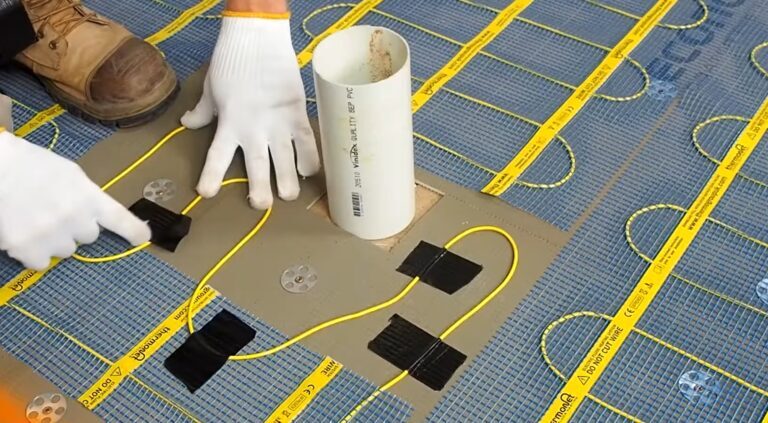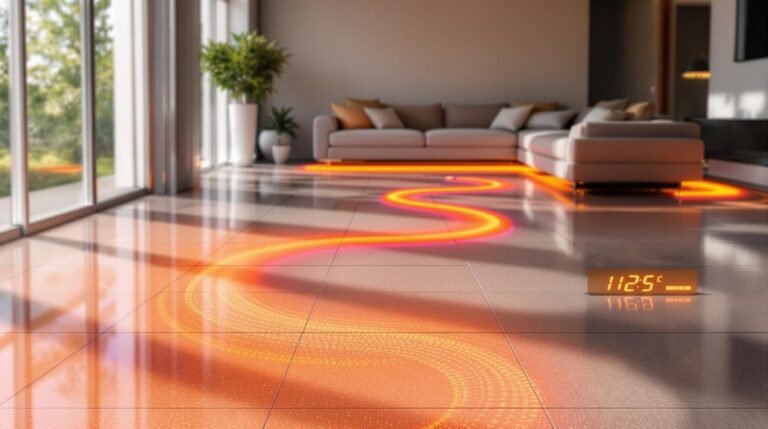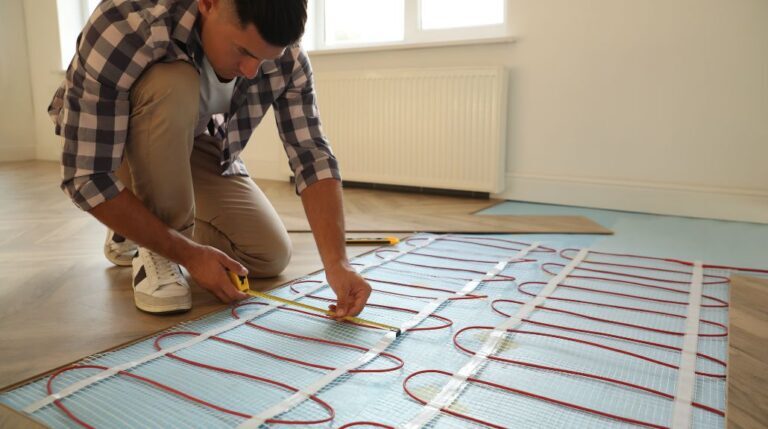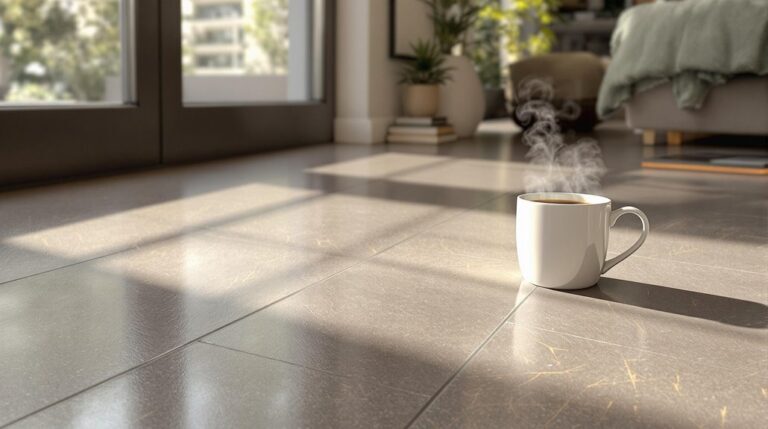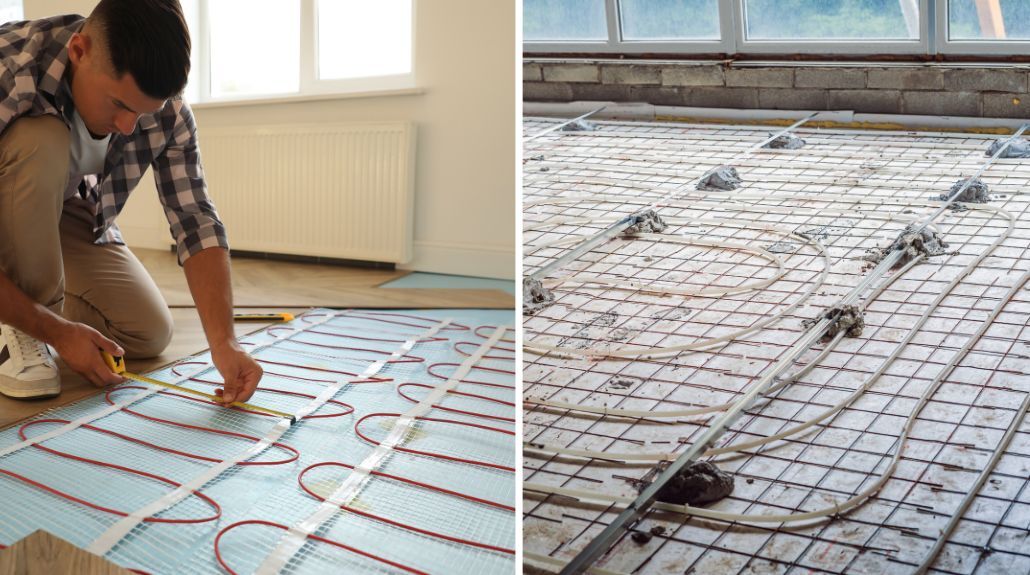
If you’ve been wrestling with the eternal warmth dilemma in your home, you’re not alone. As underfloor heating systems become increasingly popular, you’ll find yourself facing two main contenders: electric and hydronic solutions. Each system comes with its own set of advantages that could make it your ideal choice, but they also have limitations you’ll need to take into account. Whether you’re renovating your bathroom or building a new home, knowing the key differences between these systems will help you avoid costly mistakes and guarantee your toes stay toasty for years to come.
Key Takeaways
- Electric systems are better for small spaces and quick heating, while hydronic systems suit larger areas needing consistent warmth.
- Hydronic systems have higher upfront costs but lower operating expenses, offering better long-term value for large installations.
- Electric systems are easier to install and maintain, making them ideal for DIY projects and simple renovations.
- Hydronic systems last up to 50 years compared to electric’s 25 years, providing better longevity with proper maintenance.
- Electric systems offer precise temperature control and quick response, while hydronic systems provide more uniform heating distribution.
Understanding Electric and Hydronic Underfloor Heating Systems
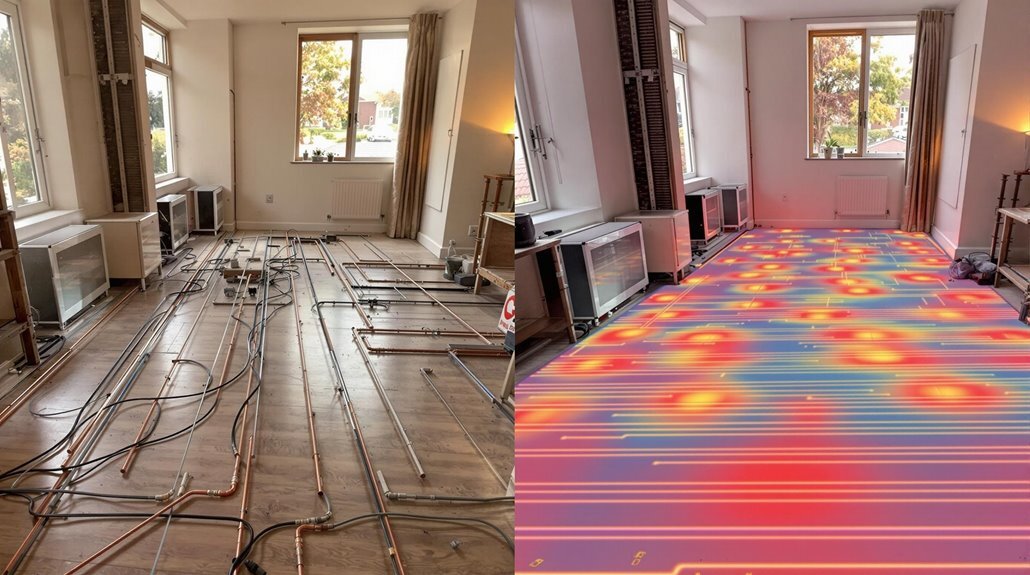
As a seasoned provider of underfloor heating solutions in Sydney, I’ve seen countless homeowners grapple with choosing between electric and hydronic systems.
Let me break down these two main types of underfloor heating to help you understand their fundamental differences.
Electric underfloor heating uses cables or heating mats installed beneath your floor surface. These systems convert electrical energy directly into radiant heat, providing quick warm-up times and excellent temperature control through programmable thermostats.
You’ll find they’re particularly effective when paired with proper insulation, which prevents heat from escaping downward.
Hydronic underfloor heating, on the other hand, works by circulating hot water through a network of pipes under your floor. While these systems can be highly energy efficient, they typically take longer to heat up and cool down compared to their electric counterparts.
The system flexibility is somewhat limited due to the complexity of the pipe network and water circulation requirements.
When it comes to maintenance needs, electric systems have a clear advantage. They require minimal upkeep and rarely need servicing, whereas hydronic systems may require periodic maintenance and can face challenges with potential leaks.
Both systems benefit from proper insulation, but electric systems offer greater flexibility in installation and retrofitting options.
For many Sydney homeowners, the choice often comes down to installation context and specific needs.
Electric systems are typically more practical for retrofitting and smaller spaces, while hydronic systems might be worth considering for new builds or larger areas where the initial setup complexity isn’t a limiting factor.
Comparing Installation for Electric and Hydronic Underfloor Heating
Nearly every installation project starts with careful planning and preparation, regardless of whether you choose an electric or hydronic system. When comparing electric vs hydronic underfloor heating, you’ll find that installation complexity varies greatly between the two options.
Electric systems typically offer a more straightforward installation process, making them suitable for both new builds and renovation projects.
At Floor Heating Today, we’ve found that space suitability plays an essential role in system selection. Electric systems work exceptionally well in smaller spaces and can be installed with less disruption to existing structures.
Hydronic systems, while more complex, are ideal for larger areas but require extensive pipework that’s best implemented during new construction.
Insulation requirements are vital for both systems, but electric installations generally need simpler insulation materials.
We always emphasize the importance of proper subfloor preparation and leveling before any installation begins.
When it comes to DIY feasibility, electric systems can be installed by experienced DIYers, though we strongly recommend professional installation for maximum performance and safety.
Safety and testing are paramount in any installation. Electrical safety measures, including proper GFCI protection and UL/cUL certified components, must be implemented.
Professional installation guarantees compliance with local regulations and includes thorough system testing before completion.
While electric systems eliminate the risk of water leaks, they require expert electrical connections.
That’s why we always conduct extensive testing and provide detailed documentation for every installation we complete.
Energy Efficiency and Costs of Radiant Heating Systems
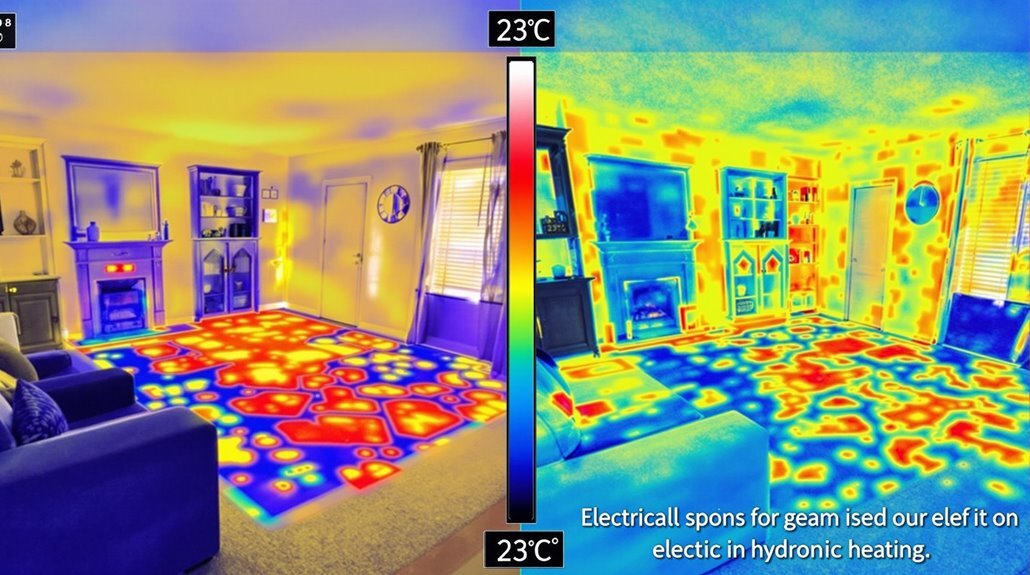
The proper installation sets the foundation for your system’s energy efficiency and operating costs – two factors that greatly impact your long-term satisfaction.
When comparing hydronic vs electric underfloor heating, each system offers distinct advantages in these areas.
Electric underfloor heating systems excel in short-term efficiency, heating up quickly and providing immediate warmth. They’re particularly cost-effective for smaller spaces, with running costs ranging from 4.67p per hour for a bathroom to 20.33p per hour for a living room.
You’ll find they’re surprisingly economical when paired with a programmable thermostat, which helps eliminate energy spikes and maintains ideal temperature control.
Hydronic underfloor heating, while requiring a higher initial investment, typically delivers superior long-term efficiency, especially in larger spaces. The operating costs tend to be lower over time, making it an attractive option for whole-house heating solutions.
When combined with energy-efficient heat sources, hydronic systems can greatly reduce your energy bills.
Both systems benefit from proper insulation, which can improve efficiency by up to 50%.
In our experience at Floor Heating Today, we’ve found that electric systems are ideal for renovation projects and smaller rooms, while hydronic heating proves more cost-effective for new constructions and larger homes.
To help you make an informed decision, we recommend considering your specific space requirements, usage patterns, and long-term energy goals.
The cost comparison between the two systems ultimately depends on these factors, along with your local energy rates and climate conditions.
Environmental Benefits of Hydronic and Electric Underfloor Heating Systems
Environmental sustainability stands at the forefront of today’s heating decisions, and we’re proud to say that both electric and hydronic underfloor heating systems offer noteworthy ecological advantages. When you choose underfloor heating, you’re reducing embedded carbon by up to 93% compared to traditional radiators. The systems we install require fewer materials and boast an impressive material lifespan of up to 50 years – double that of conventional radiators.
Your environmental impact noticeably decreases with underfloor heating’s compatibility with renewable energy sources. Whether you’re using solar power or geothermal energy, both electric and hydronic systems integrate seamlessly with these sustainable power sources. This integration leads to substantial emissions reduction and decreased reliance on fossil fuels, contributing to better air quality in your home and community.
We’ve noticed a growing focus on waste reduction in construction, and underfloor heating excels in this area. The streamlined installation process produces minimal waste, and the PE-RT pipes we use are fully recyclable. The system’s longevity means you won’t need frequent replacements, further reducing your environmental footprint.
The sustainability benefits differ slightly between electric and hydronic systems. Electric systems are thinner and ideal for renovations, requiring less material overall. Hydronic systems, while requiring more initial materials, offer excellent long-term durability and are particularly suited to new builds where you can plan the installation thoroughly.
Both options demonstrate our commitment to environmental stewardship through efficient design and responsible material usage.
Comfort and Temperature Control in Radiant Heating Systems
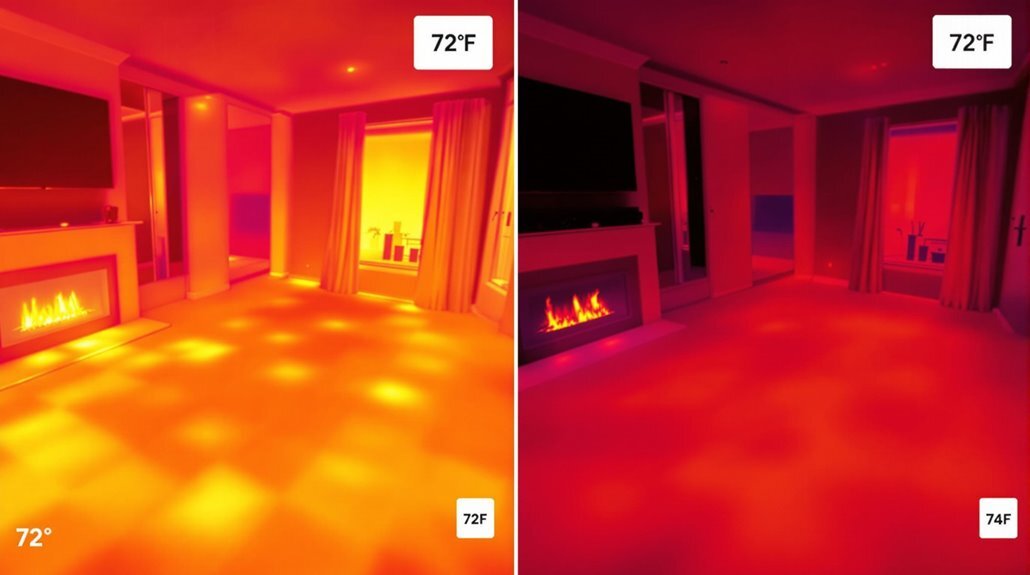
Mastering comfort and temperature control stands at the heart of choosing between electric and hydronic underfloor heating systems. At Floor Heating Today, we’ve helped countless Sydney homeowners understand these vital differences to make informed decisions for their homes.
Electric underfloor heating offers exceptional responsiveness with quick heat-up times and precise temperature control. You’ll appreciate its smart thermostat integration, allowing you to create customized heating schedules and control your system remotely.
It’s particularly effective in smaller spaces like bathrooms and kitchens, where you need targeted heating and rapid temperature adjustments.
Hydronic systems, however, excel in delivering consistent comfort across larger areas. You’ll notice the difference in how they maintain stable temperatures throughout your home, operating silently while providing uniform heat distribution.
While they may take longer to heat up initially, they retain warmth more effectively due to the thermal mass of your floor structure.
Both systems offer impressive temperature control capabilities through advanced thermostats. With electric systems, you’ll have the flexibility to create zone-based heating controls and integrate them with your smart home devices.
Hydronic systems require dedicated controllers but provide superior efficiency for continuous heating in larger spaces.
When it comes to heating schedules, electric systems offer more immediate control and simpler programming options. Hydronic systems need more strategic planning due to their slower response times, but they’re ideal if you’re looking for steady, continuous heating in larger areas.
At Floor Heating Today, we recommend considering your specific space requirements and daily heating needs when choosing between these two excellent options.
Understanding maintenance requirements and system longevity is essential when investing in underfloor heating for your Sydney home. At Floor Heating Today, we’ve observed that both electric systems and hydronic systems have distinct maintenance needs that directly impact their lifespan and performance.
Electric systems typically require less maintenance and are easier to troubleshoot. With proper installation quality and regular inspections, you can expect your electric system to last around 25 years. They’re simpler to repair, and if issues arise, we can usually isolate specific sections without disrupting the entire system.
Hydronic systems, while requiring more complex maintenance, offer impressive longevity of up to 50 years when properly maintained. They need professional servicing, including periodic flushing and thorough system efficiency checks. The initial installation complexity means you’ll want experienced professionals handling both installation and maintenance.
Here are the key factors that influence the lifespan of your underfloor heating system:
- Installation quality – Professional installation following manufacturer guidelines guarantees peak performance.
- Maintenance frequency – Regular inspections catch potential issues before they become major problems.
- Usage patterns – How you operate your system affects its durability and efficiency.
- Environmental conditions – Sydney’s climate and your home’s specific conditions impact system longevity.
When comparing both systems, remember that while hydronic systems may last longer, they require more extensive maintenance. Electric systems offer easier maintenance but have a shorter lifespan.
At Floor Heating Today, we’ll help you maintain whichever system you choose to guarantee it reaches its maximum potential lifespan.


